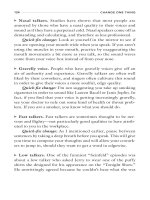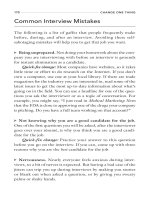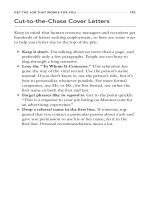Change One Thing Discover Whats Holding You Back and Fix It With the Secrets of a Top Executive Image Consultant_5 potx
Bạn đang xem bản rút gọn của tài liệu. Xem và tải ngay bản đầy đủ của tài liệu tại đây (356.55 KB, 23 trang )
no WallFloWers alloWed
101
8. I never leave someone I’ve just met at a party standing
alone.
9. If a businessperson is a peer, I can call that person by his or
her first name.
10. I always address an elderly person as Mr. or Ms. unless the
person tells me otherwise.
11. When introducing people at work, I say the highest-level
person’s name first.
12. Business discussions during a luncheon should begin
immediately after everyone is seated.
13. The purpose of a breakfast meeting is to discuss business.
14. I network at least once a month.
15. Posting a video of myself on YouTube is a great way to pro-
mote myself.
16. Men should always pick up the check, even if the boss is a
woman.
17. When I take a client out to lunch or dinner, I like to try
new restaurants.
Answers:
Use these answers to see what you need to change when you are
socializing with coworkers or clients.
1. False. It is important to entertain business associates from
time to time, because it gives you the opportunity to get to
know them better while they get to know you. This doesn’t
mean you have to invite them to your house for dinner, but you
might want to ask them out for coffee, drinks, or lunch. Getting
to know someone outside the office allows you to relax a bit and
connect on a whole new level.
102
change one Thing
2. True. More and more executives are playing golf today, so it
is helpful to know a few simple rules, in case you find yourself on
the links. Private country clubs have specific dress codes for men
and women, which call for shorts or chinos, not jeans. When
you are playing golf at a public course, you can wear whatever
you please. Golfers at private clubs dine at either a grill, which
is casual, or a formal dining room, so never ask for the “restau-
rant” if you are at a country club. Also, most country clubs do
not deal in cash, except perhaps for caddy gratuities, so make
sure to bring a credit card.
3. True. If you want to be at the top of your game in today’s
global business world, it’s important to understand that differ-
ent countries have different codes of behavior. Most Americans
know, for example, that Asians do not shake hands, they bow.
In Mexico it is customary for the arriving person to greet oth-
ers first. In France, people greet their friends with two or more
kisses on each cheek. In Russia, women often walk arm in arm
with their female friends. Knowing and respecting customs and
cultural differences will reflect well on you and make it easier to
assimilate so you can conduct business. Ignoring cultural dif-
ferences can blow a deal—or, at the very least, create some awk-
ward moments.
4. True. You should carry your business cards with you wher-
ever you go, even to the supermarket, because you never know
whom you might meet. You might not always want to give it
out, but you should never leave home without one.
5. True. Not giving out your business card unless you are asked
is a little-known but important etiquette rule. This is especially
true if you are with a senior-level person. The exception to this
no WallFloWers alloWed
103
rule is at a business meeting or networking event, when it is
expected that you exchange cards.
6. True. When networking, try to keep your right hand free, so
you can shake hands with people you meet. If you are having
cocktails, hold your drink in your left hand. Do not try juggling
an hors d’oeuvres plate and a drink, because you won’t be able
to do both. Remember, you’re not there to eat and drink; you’re
there to meet and greet!
7. True. Don’t return to the buffet table more than once at a
business function, because you would be wasting good time
that you could devote to networking. Plus, you can’t talk with
your mouth full. Eat before you go, so you won’t be hungry and
tempted to graze.
8. True. It is bad form to abandon someone you have just met at
a party. Introduce that person to someone else, and then excuse
yourself before circulating.
9. True. It is OK, especially for Americans, to call a business
peer by his or her first name. If someone is at a higher level, wait
for an introduction to get an idea of how to address him or her.
10. True. It is a sign of respect to address an elderly person as
Mr., Mrs., or Ms., unless he or she tells you otherwise. While
this kind of formality is disappearing in the workplace, you
might encounter people at a senior level who remember when
this was the accepted form of address rather than the exception.
11. True. Always start your business introductions with the
highest-ranking person first. As in the military, business follows
104
change one Thing
a chain of command, and CEOs, like generals, outrank the pri-
vates or junior executives.
12. False. When you are at a lunch meeting, you want to ease
into business so that you will have a chance to enjoy your food.
Start with some small talk over appetizers before you move into
the business entrées.
13. False. Breakfast meetings are by nature faster and less formal
than lunches or dinners, so they are often reserved for getting
to know a client or colleague. This doesn’t mean you can’t talk
business, but you don’t necessarily have to jump right in before
your eggs and coffee.
14. True. Growing your circle of influence is a good way to stay
up-to-date with what’s going on in your industry and to make
connections that you might need later on in your career, should
you decide to change jobs or companies. Networking can be as
varied as going out for coffee, playing a game of tennis with col-
leagues, and writing a few quick e-mails to catch up with other
people in your industry.
15. False. Placing a video on YouTube can be helpful if you are
in a creative field like entertainment or advertising, but most
businesses do not look to YouTube as a place to find potential
hires. Better places for online networking are the networking
sites LinkedIn and Plaxo.
16. False. If your boss is a woman and you are a man, she should
be the one picking up the check. You are not dating; you are
having a business meal.
17. False. Never take a client to a restaurant you haven’t been
to before, even if you heard it was good. You wouldn’t try out a
no WallFloWers alloWed
105
new recipe at a dinner party, so why run the risk of having a bad
experience at a business meal? Plus, you often get better service
at places where you are a regular customer.
The following social-protocol quiz will help you assess your
business manners.
ANSWER TRUE OR FALSE:
YY
1. I order first when dining out, so my companion will feel
more comfortable.
2. Beverages should always be served from the right, and food
served from the left.
3. It is OK to have more than two alcoholic drinks at a busi-
ness lunch.
eleganT social skills
Y YYY
Your mother was right when she told you to mind your man-
ners. Remembering the following basic protocols will give
you what I consider elegant social skills:
Smile and greet people you know when you pass them in
Y
the hallway or on the street.
Say “please” and “thank you.” (You would be surprised at
Y
how many people forget their basic manners.)
Admit when you are wrong.
Y
Have a sense of humor.
Y
Remember people’s names.
Y
Be sensitive to another person’s point of view.
Y
Return phone calls and e-mails within twenty-four hours.
Y
106
change one Thing
4. I understand the difference between dining American and
Continental style.
5. When eating a salad, it is OK to use a fork to cut the
lettuce.
6. I pass food to the right.
7. I always season my food first before I taste it.
8. I tip only for good service.
9. I put my napkin on the table when I leave to go to the rest
room.
10. I always ask the price of an item of food when ordering.
11. The bread-and-butter plate is on the right side of a place
setting.
12. Complaining about the food shows that I have high
standards.
13. It is not necessary to make reservations for lunch or
breakfast.
14. I like to arrive “fashionably late” to a dinner party.
15. I always send a thank-you note after being taken out to a
restaurant.
16. It’s OK for me to talk or text on a cell phone when I’m in a
restaurant.
Answers:
These answers will help you see what you might need to change
about your social skills.
1. False. A good rule of thumb is to let the person being taken
out to dinner order first. If you are going dutch, then “ladies
first” should apply. If you’re all women, let the person who is
ready to order go first.
no WallFloWers alloWed
107
2. True. If you are throwing a dinner party, remember to serve
the beverages from the right with your right hand, and serve
the food from the left with your left hand. This is the way fine
restaurants do it. You can make an exception if you don’t have
access to both sides of a guest.
3. False. While it’s true that alcohol is a social lubricant, be care-
ful not to have more than two drinks at a business lunch. Cock-
tails can loosen our tongues and inhibitions, and you do not
want to say or do something you might regret later on.
4. True. The American style of dining means you place your
knife down on your plate after cutting your food. The Conti-
nental style involves keeping your fork in your hand after cut-
ting your food and eating with the fork facing down. Decide
which method works best for you, and use it. Europeans also
eat salads and cheese after their entrée. European portions tend
to be smaller than Americans are used to, so don’t complain to
the waiter at a French restaurant that you were shorted. Eating
reasonable portions is one reason why Europeans don’t suffer as
much from obesity as we super-size-loving Americans do.
5. False. If you don’t need to cut your salad leaves, don’t, but
sometimes it is necessary, depending on the types of greens
being served. If you are given a salad knife, use that. If not,
it’s probably best to use any available knife to make eating your
salad more manageable, so it doesn’t look like it’s feeding time
at the zoo.
6. True. Always pass your food to the right after serving your-
self. The exception to this rule arises if the dish has already made
108
change one Thing
the rounds in the other direction. In that case, you should go
with the flow.
7. False. Always taste your food before you season, because you
don’t know whether or not the dish needs any more condiments
until you try it.
8. False. Waiting tables is a tough job, and your servers might
be having a bad day, so give them the benefit of the doubt, and
tip. Waiters rely on tips for most of their earnings. How much
you tip depends on the level of service you received. Tip 20 per-
cent of the bill for excellent service and 15 percent for an effi-
cient job—less only if you were ignored completely or treated
rudely.
9. False. Always put your napkin on the chair when you go to
the rest room. Putting your napkin on the table means you are
leaving. In fine restaurants, the server will refold your napkin
and place it back on the table while you’re gone.
10. False. Do not ask the price of the food before ordering;
that’s what menus are for. You can ask to hear the specials if your
server hasn’t already given you a rundown the chef’s selections.
If the specials aren’t listed on the menu, many servers will give
the prices at that time. If not and you are concerned about price,
go with something on the menu.
11. False. The bread-and-butter plate should always be on the
left side of the place setting above the fork. The butter knife
should be laid on the small plate diagonally. Water and wine
glasses are on the right above the knife.
12. False. If you are someone’s guest, do not complain about
the food, no matter how bad you think it is. It will make you
no WallFloWers alloWed
109
look like a whiner, not a gourmet. Should there be a legitimate
problem with your food, discreetly tell the waiter, not the host,
what the trouble is.
13. False. As you would do for dinner, it’s a good idea to make
reservations for breakfast and lunch, even if you think the res-
taurant won’t be crowded. If you take your chances, you might
not get a table, which is annoying and embarrassing if you are
taking someone out. Plus, restaurants appreciate the notice.
14. False. The only thing you accomplish by being late for a
dinner party is to make yourself look disrespectful. If the invita-
tion says dinner at 8:00
p.m., coming a half hour later will throw
off the host’s schedule and keep other guests hungrily awaiting
your arrival.
15. True. Always send a thank-you note after being taken out to
a restaurant, whether it is handwritten or an e-mail.
16. False. It is rude to text or speak on a cell phone when you
are at a restaurant, especially if you have dining companions. If
you must be reachable in case of an emergency, put your phone
on vibrate, and excuse yourself from the table to take the call.
The same goes for cell phone use in elevators, on public trans-
portation, at cinemas and theaters, or anywhere you have a cap-
tive audience.
Anna’s Social-Image Tips
The following advice will help you to feel comfortable in almost
any situation, whether you are at your office holiday party, hav-
ing dinner with a friend, or on a business trip abroad.
110
change one Thing
A Party Where You Don’t Know Anyone
We’ve all been there. You walk into a room where you don’t
know anyone, and everyone else is standing around in seemingly
impenetrable clutches. What do you do? The first thing you
need to do is to seek out someone who is standing alone. If you
can’t find anyone who is solo, try groups of three or more. Never
break into a group of only two, because they might be having a
private conversation. If the group is larger than five, you can get
lost in the crowd, which is fine if you don’t mind stepping back
and observing for a while. I also recommend going to the host,
who will introduce you to someone at the party. Offering to
help the host is also a good idea. It is easier to break the ice when
you are literally breaking some ice to hand someone a drink!
Faux Pas Fixes
Have you ever been at a party where you have forgotten the
name of someone you’ve known for years? Have you ever spilled
red wine on a dinner companion or a host’s white rug? These
common yet embarrassing social faux pas moments don’t have
to send you running for the exit. There are ways to gracefully
get out of the most uncomfortable situations. Here are ten tips
to take along with you to your next social event:
1. You have forgotten someone’s name. Admit it. Do not pre-
tend you know someone’s name when you don’t. Just say, “I’m
so sorry, I’ve forgotten your name,” or, “I remember great faces
but not names; what is your name again?”
2. You have been introduced by the host, but he or she did
not use your name.
When the reverse happens, take pity and say
no WallFloWers alloWed
111
your name when you shake hands with the person you are being
introduced to: “Anna Wildermuth—nice to meet you.” If you
are in a crowd and the host has neglected to introduce you at all,
make the move yourself. With someone you’ve met in the past,
reintroduce yourself by saying, “I don’t know if you remember
me. I’m Anna Wildermuth.”
3. You’ve spilled a drink on a dinner companion. Do not touch
the person you’ve spilled your drink on. Instead, call the waiter
or waitress over immediately. Offer to pay for the dry cleaning.
If the person is a woman and she refuses, send flowers the next
day. If it is man, send him a great business book. Apologize sin-
cerely, and then let it go.
4. You freeze in the middle of a toast. Take a deep breath,
pause to collect your thoughts, and pick up where you left off.
You can also begin the sentence again, which might jog your
memory. Make sure to look for a friendly face to help you relax.
It can help to make a joke about it by saying something like,
“Sorry, I’m having a senior moment,” if applicable, or, “Sorry, I
got so excited about what I was saying, I lost my place.” My pref-
erence is to take a deep breath and start again to avoid a break in
the momentum.
5. Someone has had too much to drink and starts heckling
or being rude while you’re making a toast.
Stop your speech,
and calmly turn to the host to ask that the offending person be
removed. You can also politely ask the person to leave the room
yourself, and do not start again until he or she leaves. Whatever
you do, do not engage the rude person in an argument. Other
than professional comedians, most people don’t have the verbal
artillery to deal with hecklers.
112
change one Thing
6. Someone has made an ethnic or sexist joke. Give this person
a pass, especially if you suspect that he or she is unaware of how
offensive the joke was. Ignore the joke without laughing, and
quickly start another conversation. If the person has made an
You Won’T geT a second chance To Make
Y
a good FirsT iMpression
YYY
In 2007, I conducted an unscientific survey of approximately
300 men and women who went to my Illinois workshops,
asking them to identify the most important factor in arriv-
ing at first impressions. The participants included Caucasians,
African-Americans, Latinos, and Asians between the ages of
20 and 60. As expected, clothes and face topped the list, but
I was surprised (and secretly pleased) that age came in last.
Here are the top ten things my students noticed about some-
one they had just met:
1. Clothing
2. Facial expression
3. Posture
4. Hair
5. Eye contact
6. Smile
7. Hygiene
8. Confidence
9. Speech
10. Age
no WallFloWers alloWed
113
offensive joke in a group, it’s even easier to ignore it and move
on, if those around you do the same.
7. You’re talking to someone who is unbearably boring, and
you want to circulate without hurting his or her feelings.
This is called the breakaway. You say, “Let’s go talk to [another
person in the room].” You take the person to another group, stay
awhile, and then tell the person you see someone in the room
you have been trying to get a hold of for some time. Tell the
boring person it was good to see him or her and hope you will
see each other again before you leave.
8. Someone asks you how much you make. Tell the person you
had a good year or that it was close to meeting your expectations,
but don’t give a figure. If you are self-employed, say, “I’ll have to
ask my accountant. He [or she] keeps track of my finances.”
9. Someone starts gossiping about another person you both
know.
According to a University of Michigan study, when it
comes to gossip, the most powerful person is the one who is
receiving the information. You can put an end to gossip by not
acknowledging it and changing the subject. Changing the sub-
ject sends the message that you are not interested in spreading
the news.
10. You run into someone with whom you’ve had a falling-out.
If the person says hello, you want to be courteous and return the
greeting with a smile. It is your choice whether to make small
talk or not. If you were the wronged party, a smile followed by
a simple hello before moving on is sufficient. If the other person
was the wronged party, you can make small talk to check out the
114
change one Thing
reception and, after a bit of conversation, apologize again. If he
or she is ignoring you, look for favorable body language and eye
contact to help you make the decision about whether or not to
approach.
Multicultural Business Etiquette
While it’s hard enough to remember which fork to use when
eating out, chances of making a faux pas are even greater when
you’re traveling abroad. If your company hasn’t provided you
with some cultural background information, go online (perhaps
to a government-sponsored website) or buy a travel guide, and
do your homework before you get off the plane. Here are some
customs to keep in mind when doing business abroad:
China.
Y
In China it is insulting to finish all the food on
your plate and ask for seconds, because the host will think
you were not given enough food. And don’t discuss busi-
ness over dinner when you first meet someone. Keep the
conversation light until you get to know your host.
Eastern Europe.
Y
Americans are accustomed to greeting
one another with a cheery, “How are you?” and getting an
equally sunny, “Fine, thanks. How are you?” in response.
This kind of question is deemed odd, however, in Eastern
Europe, where one is more likely to give a more honest
answer, such as “Terrible!” Therefore, a simple “hello” will
suffice.
Germany.
Y
If you are celebrating a birthday in Germany, it
is up to you as the birthday boy or girl to provide a treat
for your well-wishers, not the other way around. Make sure
no WallFloWers alloWed
115
you take some goodies with you to work if your coworkers
know it’s your birthday.
Japan.
Y
Ginsu knives aside, it’s not a good idea to give a Jap-
anese person knives as a gift, because it symbolizes cutting
ties with the recipient.
Middle East.
Y
People from Middle Eastern countries do
not use their left hand for greetings or to hand an object to
someone, because the left hand is considered unclean.
This page intentionally left blank
117
6
CAN YOU HEAR
ME NOW?
Change One Thing About Your
Communication Style
Th e r e ’s n o q u e s T I o n
YY
that the ability to communicate with
others effectively is an essential part of doing business. It involves
being a good listener and knowing how to speak clearly and
concisely. It means not speaking too fast or too slow. It means
looking people directly in the eye when you are having a conver-
sation, and not standing too close or being too standoffish.
Part of being a team player in business is being in sync with
others, and you can do this by paying attention to the way you
communicate. If you speak too fast, you run the risk of losing the
other person’s attention or respect. If you ramble on from one
sentence to another, you will sound unfocused or flighty. Speak-
ing too slowly will bore people or make them want to jump in
118
change one Thing
to finish your sentences. Pay attention to your audience. If they
look shell-shocked or confused, you’ve lost them.
Professor Alex Portland of the Massachusetts Institute of
Technology recently invented a smart phone that allows users to
evaluate their conversations for tone, cadence, and the number
of times one interrupts. Dr. Portland believes people can some-
day use the data to change their unproductive speech patterns
and improve workplace dynamics. Until then, you can assess
your own speech patterns and tones by recording yourself or
calling your voice mail and leaving a message. Listen for the
speed and clarity of your voice. Are you high-pitched? Do you
mumble or speak too softly? Whatever your particular problem
is, ask a friend to give you a gentle nudge in the ribs whenever
you fall off the wagon.
The following quiz will help you define and refine your
communication style.
ANSWER TRUE OR FALSE:
YY
1. I always look people in the eye when talking or listening to
them.
2. I keep an arm’s length away from someone I’m talking to.
3. I am comfortable making small talk.
4. I am comfortable talking to people I do not know.
5. I am comfortable talking to people I do know.
6. I am comfortable speaking in front of a small group.
7. I am comfortable speaking in front of a large group.
8. Most people find me easy to talk to.
9. I can clearly explain what I do in under a minute.
10. I organize my thoughts before I speak.
can You hear Me noW?
119
11. I enunciate clearly.
12. I’m a good listener.
13. I ask questions.
14. When I first meet someone, I use his or her name at least
once during our conversation.
15. I smile frequently.
16. I respect others’ opinions, even if I disagree with them.
17. People can hear me when I speak.
Answers:
1. True. Always make eye contact when you are talking to
someone. Eye contact shows confidence in yourself and says
you are interested in what the other person is saying. People
who have trouble making eye contact appear shifty, shy, or
uncomfortable.
2. True. Most people maintain this distance naturally, but some
cultures are closer talkers than others. Personal space is impor-
tant in the United States, so always stay an arm’s length away
from the person you are talking to. Where do you think the
expression “too close for comfort” came from?
3. True. People with good social skills are comfortable making
small talk, no matter how inane the topics. If you have trouble
with this, read newspapers and magazines (gossip magazines are
good for conversation starters), watch the TV newscasts, or go
online to check out some blogs. Seeing the latest movie or reading
a good book is also helpful, but the other person has to have read
or seen what you have to make this work, so you should always
have something else in your small-talk arsenal just in case.
120
change one Thing
4. True. If you are uncomfortable meeting new people, practice
by striking up conversations with strangers. The next time you
are in a checkout line, ask the person in front of you about an
item he or she is purchasing. For example, “Is that good? I’ve
always wanted to try it.” It doesn’t matter what you say, as long
as you practice meeting new people. Complimenting someone
on an article of clothing or piece of jewelry is another good way
to strike up a conversation: “I like your shoes; where did you get
them?” Women have an easier time doing this than men, but
most men use sports as their universal language.
5. True. If you are uncomfortable talking to people in general,
make sure that you smile often and reflect back on what others
are saying until you feel more relaxed and ready to speak up.
6. True. Speaking in front of a small group is a whole lot easier
than speaking in front of a room full of people. If you responded
False to this statement, join a book club, which usually has no
more than ten people in a group, and talk about a book you’ve
just read. Any club that doesn’t have a large membership will
work as well.
7. True. I frequently speak in front of large audiences, and some-
times I still get the jitters, so if this describes you, don’t feel bad!
I usually just say to myself, “Anna, get over it!” This may or may
not work for you, but it does for me. If you are speaking in front
of a large group, seek out a friendly face, and talk directly to that
person. Look around the room for someone who is nodding or
smiling. Keep in mind that unless you are a celebrity, people are
not there to see you; they are there to get the information you
are giving. Remembering this will take some of the pressure
off.
can You hear Me noW?
121
8. True. One of the keys to being a good communicator is for
other people to find it easy to talk to you. If they don’t, you are
probably coming off as intimidating. Watch your facial expres-
sions and body language. Do you frown a lot? Do you fold your
arms in front of you? Do you refuse to make idle chitchat? Find
out what is putting other people off, and change it!
9. True. Make sure you know how to explain what you do in
thirty to sixty seconds. Think of that explanation as a commer-
cial for yourself! This is especially important when you are net-
working or during a job interview. How do you serve the public
or company you work for? Even more important is communicat-
ing that you love what you do. Enthusiasm goes a long way.
10. True. I mention this a lot, but I can’t emphasize it enough.
Take time to organize your thoughts before you speak. When
you are asked about a topic that requires some explanation,
you could say, “That’s a good question,” which will give you a
moment to pause and think before you speak.
11. True. A crucial part of being a good communicator is being
understood. When you mumble, people are forced to ask you to
repeat what you’ve just said, which is tiresome. Practice reading
a paragraph with a pencil in your mouth. Then take the pencil
out, and read the paragraph again. I know it sounds strange, but
this trains the muscles to work harder when you speak.
12. True. Many people like to hear themselves speak, but con-
versation is a give-and-take. Make sure you listen. Being a good
listener not only shows respect for others, it’s also one of the
most important qualities a businessperson can have, because the
opinions of others will inform your own decisions.
122
change one Thing
13. True. One of the ways to show you are a good listener is to
reflect on what the other person is saying. You can do this by
asking questions. Don’t assume; ask.
14. True. Using a person’s name a few times during the course
of a conversation will help you remember it in the future. It also
helps you learn the correct pronunciation, should they have an
unusual name.
15. True. Don’t be fake or clownish, but smiling makes just
about everyone look more attractive and approachable.
16. True. Never dismiss someone else’s opinion, even if you dis-
agree. Simply agree to disagree, and leave it at that.
17. True. Are you often asked to repeat yourself like that “Can
you hear me now?” commercial for a cell phone company? If
you are a low talker, practice projecting by standing in front of a
friend and saying your name. Then, move an arm’s length away,
and continue saying your name so your friend can hear you. Put
your hands on your throat so you can feel what it is like to speak
up. (See the next section for more communication style tips.)
Your Voice Speaks Volumes
About Your Personality
Even if you have a sterling résumé, looking good on paper is not
always enough for you to get that promotion you’ve been vying
for or to reach that next round of interviews in your job search.
can You hear Me noW?
123
The truth is, your voice speaks volumes about your personality,
and it can have a negative or positive effect on your personal and
professional life. A recent Stanford University study found that
people make judgments about a person’s credibility based on the
way he or she speaks. Listen to a recording of yourself to figure
out what your speaking style is, and then read the following tips
for working on what needs fixing.
High-pitched talkers.
Y
If you have a squeaky or high-pitched
voice, people might think you are insecure and inexperienced.
Grown women who sound like little girls are not always taken
seriously by their coworkers. High-pitched talkers will be
shunned because no one wants to be in the same room with
someone who sounds like a smoke alarm.
Quick‑fix change: Having a voice that naturally sounds like
Minnie Mouse doesn’t mean you have to stay that way forever.
Invest in a session or two with a professional speech pathologist
or vocal coach to see if you can take it down a notch or two.
Slow talkers.
Y
Slow talkers can come across as confident and
often gain the respect of their colleagues. If you talk slowly, you
have a calming effect on others (think yoga teachers), because
you appear to be relaxed and in control. If you speak too slowly,
however (think Ben Stein as the teacher in Ferris Bueller’s Day
Off), with several seconds elapsing between words for no appar-
ent reason, you will irritate others, who are silently begging you
to get to the point already!
Quick‑fix change: Try listening to someone who speaks at a
normal clip, and practice mimicking their tempo while reading
a book until you pick up the pace a bit. Drink a double espresso
before doing this exercise, and see if that helps.









